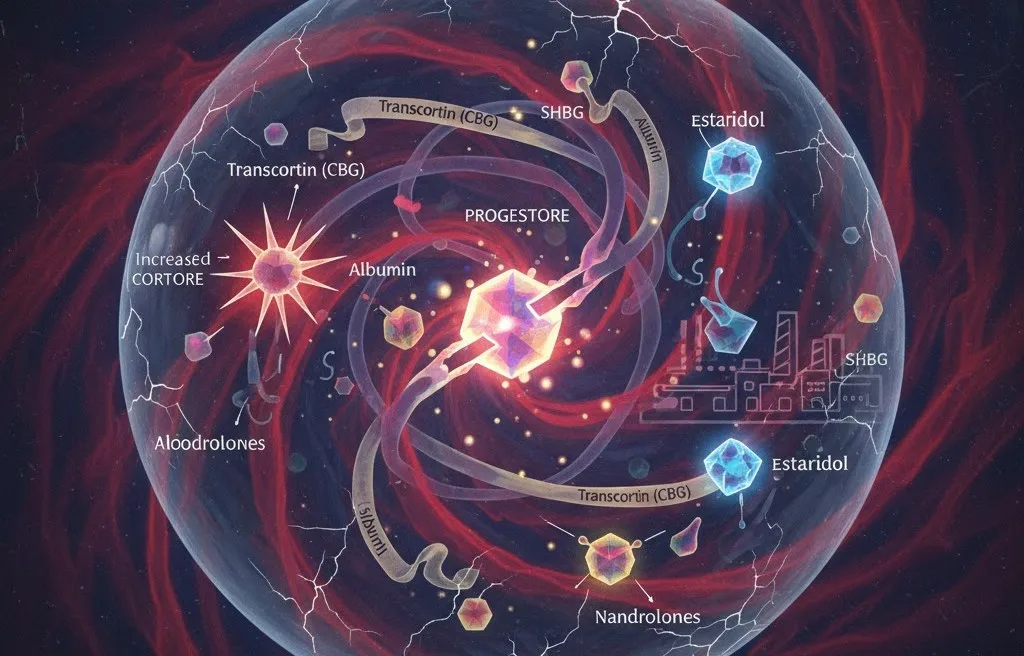Hormones do not act in isolation. Their activity is intricately regulated by transport proteins, enzymatic pathways, and feedback mechanisms. Progesterone, a key steroid hormone, plays a central role in this complex hormonal network — influencing and being influenced by other hormones such as cortisol, aldosterone, testosterone, and estradiol. Understanding how these interactions work is crucial, especially for anyone considering manipulating hormone levels through steroid use.
Progesterone and Its Binding Proteins
Once released into the bloodstream, about 98% of progesterone binds to specific carrier proteins, converting it from its active to inactive form. There are three main proteins involved:
-
Transcortin (CBG): The primary transport protein for progesterone and corticosteroids such as cortisol and aldosterone.
-
SHBG (Sex Hormone-Binding Globulin): Binds to testosterone, estradiol, and other steroid hormones.
-
Albumin: Binds progesterone weakly; progesterone attached to albumin can still exert a mild biological effect.
Only the unbound fraction (free progesterone) remains biologically active and can interact with receptors to produce physiological effects.
The Role of Cortisol and Feedback Regulation
Progesterone serves as a precursor for other hormones, including cortisol and testosterone, through enzymatic conversion pathways.
When cortisol levels rise, the liver increases the production of transcortin, which in turn binds more progesterone. This lowers free progesterone levels, triggering the body to synthesize more progesterone to restore balance.
The result is a paradox: blood tests may show elevated total progesterone, but free progesterone is reduced because most of it is bound to carrier proteins.
How Estradiol Indirectly Raises Progesterone Levels
Estradiol strongly influences protein metabolism and stimulates the liver to synthesize both transcortin and SHBG.
An increase in estradiol → raises transcortin levels → lowers free progesterone → triggers increased progesterone production.
This chain reaction is also observed during pregnancy, where rising estradiol levels lead to increased transcortin production as a physiological adaptation.
Progestogenic Steroids and Hormonal Complexity
Certain anabolic steroids, particularly nandrolones, exhibit progestogenic activity, behaving similarly to progesterone in the body. When these compounds enter the endocrine system, they can alter the delicate balance between androgens, estrogens, and binding proteins.
This is why designing and regulating a steroid cycle is far more complicated than it might appear. You’re not just introducing a single compound — you’re interfering with an entire hormonal network.
The Cortisol–Stress Connection
Cortisol, often called the “stress hormone,” is central to this balance. Even mild psychological or physical stress can increase cortisol levels, which in turn affects binding proteins and downstream hormone levels.
This highlights the importance of stress management as a foundation for hormonal stability. External manipulation through steroids can amplify these effects and make recovery even more complex.
Why Steroid Use Is Not a Simple “One Compound” Game
Many people mistakenly believe that taking a single anabolic steroid will only affect one or two hormones. In reality, a single compound can impact thousands of processes in the body through hormonal feedback loops, binding protein shifts, and enzyme activity changes. Once the compound is cleared, the physiological disruptions remain, often requiring medical or structured post-cycle intervention to restore balance.
Final Thoughts: Respect the Endocrine System
The endocrine system is a highly interconnected and sensitive network. Hormones such as progesterone, cortisol, estradiol, and testosterone are tightly regulated through binding proteins and feedback mechanisms. Disrupting this balance with external substances is not something to be taken lightly.
Before considering any form of hormonal manipulation or steroid use, it’s critical to understand the full scope of the physiological impact — not just the short-term effects, but the long-term consequences for hormone balance and overall health.

